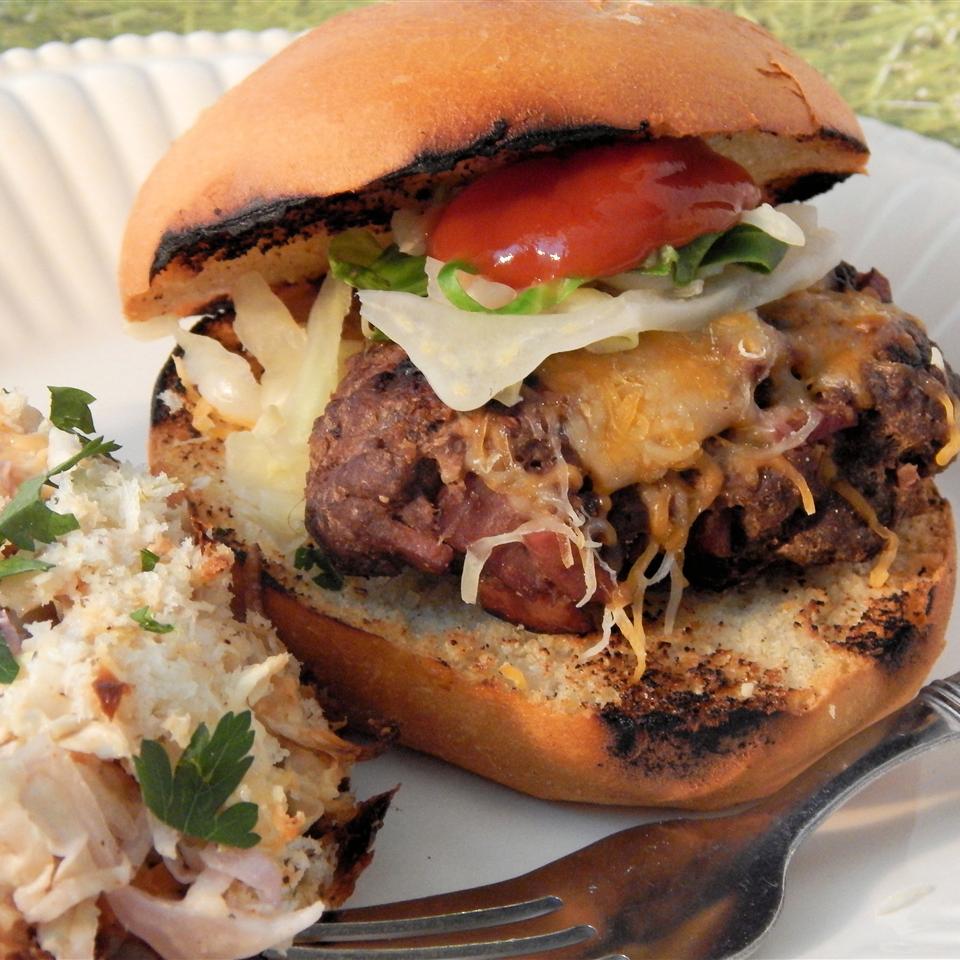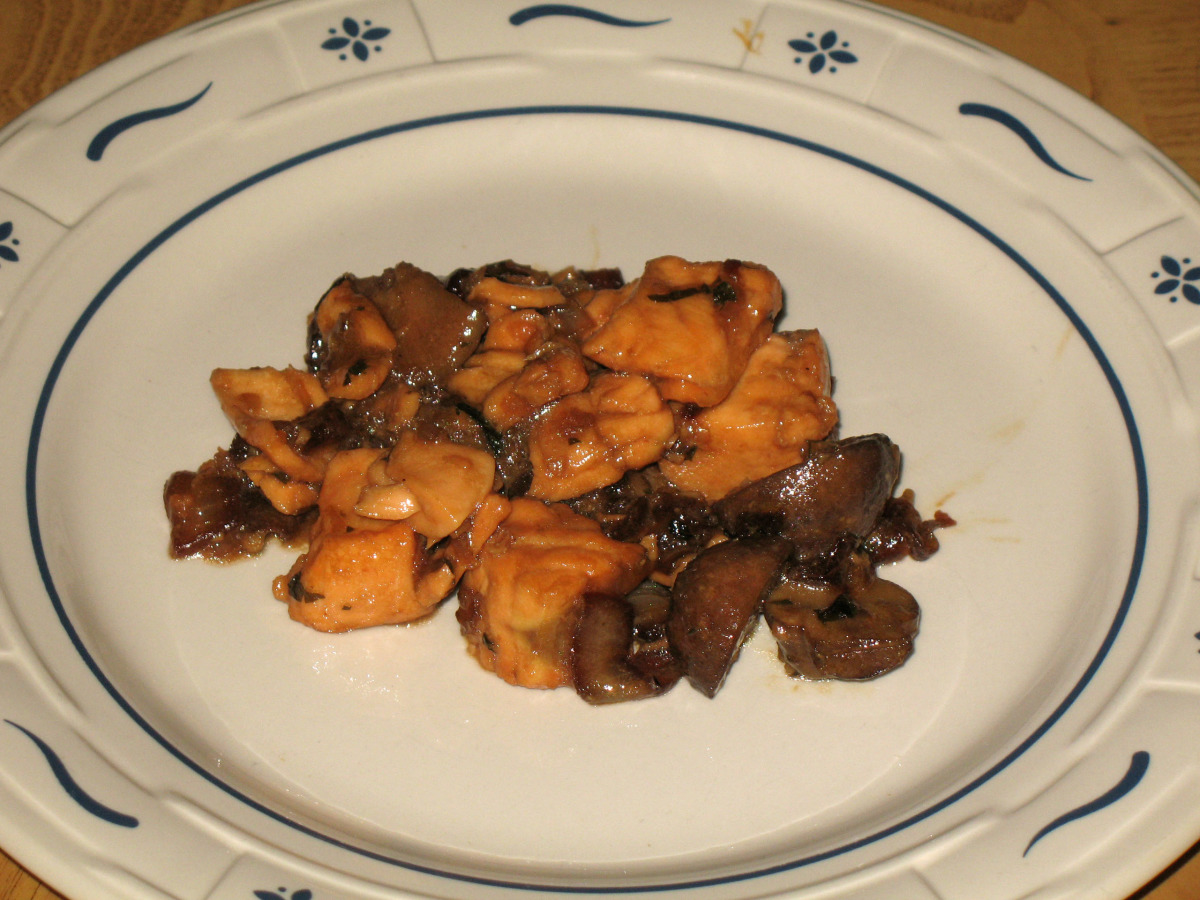In the culinary world, James Beard is a name synonymous with excellence and innovation. His recipes, spanning various cuisines and techniques, have captivated food enthusiasts for generations. This article presents a curated collection of some of James Beard's most celebrated dishes, each embodying his passion for culinary artistry. From the classic roast chicken with bread stuffing to the elegant beef Wellington, these recipes showcase Beard's mastery of both traditional and contemporary cooking methods. Whether you're a seasoned chef or a home cook looking to elevate your skills, these James Beard recipes promise to tantalize your taste buds and leave you craving for more.
Here are our top 6 tried and tested recipes!
JAMES BEARD'S FAVORITE HAMBURGER

Steps:
- Spread the meat out on a board and grate 2 to 3 tablespoons of onion into it¿use a fairly fine grater so you get just the juice and very finely grated raw onion. Now mix in about a tablespoon of heavy cream and some freshly ground black pepper, to taste. Form into patties¿a 6- to 8-ounce patty for an average serving.
- Using a black iron skillet or your best copper one or your pet aluminum frying pan, Teflon-coated or not (with a Teflon coating you won't need much fat, just a little bit for flavor), and cook the hamburgers in the butter and oil over fairly high heat, giving it 4 to 5 minutes a side, depending on how well done you like it. Salt this creamy, oniony, peppery hamburger before serving it on a buttered bun or English muffin, or as a main course with sliced tomatoes and onions or some home-fried potatoes.
JAMES BEARD'S BASIC HOME-STYLE BREAD

"Beard on Bread" was one of the very first cookbooks I ever purchased. I found his recipes to be quite reliable. This recipe uses less yeast than you might think is needed - the slower rise helps develop the taste of the bread. Beard describes this as a quite light bread, rather fine in texture and much enjoyed when fresh with a generous spreading of butter and preserves. Also popular for sandwiches and toast. Please note the amount of salt - Beard tended to salt a bit heavily, but I am posting as he wrote it. Posting this in response to a request.
Provided by duonyte
Categories Healthy
Time 5h45m
Yield 2 loaves
Number Of Ingredients 7
Steps:
- Add the yeast to 1/2 cup of the warm milk, along with 2 tbl sugar, and stir well until the yeast in completely dissolved. Allow the yeast to proof.
- Place the remaining milk, butter and salt in a bowl. (Beard liked a lot of salt, and I would use less). Stir in the flour, 1 cup at a time, with a wooden spoon.
- After the third cup, add the yeast mixture. Continue stirring in flour until the mixture is rather firm, which should take about 4 to 5 cups.
- Remove the dough to a floured board and knead, adding more flour as necessary, until it is supple, satiny and no longer sticky.
- Butter a bowl and place the dough in it, turning to coat all sides with the fat. Cover and allow to rise in a warm, draft-free spot until doubled in bulk, about 1 1/2 to 2 hours.
- Deflate the dough by punching firmly two or three times, return to the floured board, and knead 4 to 5 minutes more.
- Divide into two equal parts and shape into loaves. Place in well-buttered 9x5x3 in loaf tins, cover, and let rise again until doubled in bulk.
- Slash the loaves with a sharp knife and brush with lightly beaten egg white or water.
- Bake in a 400 deg. oven for 40 to 45 minutes or until the bread sounds hollow when tapped with the knuckles.
- Remove the loaves from the pans and put them back in the oven a few minutes longer to become crisped.
JAMES BEARD'S CHICKEN WITH 40 CLOVES OF GARLIC
This is a classic French fricassee, a Provençal dish popularized by Richard Olney, James Beard and other great cookbook writers of the postwar generation. An immense amount of garlic cooks slowly alongside the chicken, reducing the pungency of the cloves and replacing it with a thrumming sweetness and intensity. Eat the chicken in its sauce, then spread the softened garlic on bread and dip it in the remaining juices.
Provided by Molly O'Neill
Categories dinner, main course
Time 1h40m
Yield 8 servings
Number Of Ingredients 12
Steps:
- Preheat the oven to 375 degrees. Cover the bottom of a heavy 6-quart casserole with the celery and onions and add the parsley and tarragon. Place the oil in a shallow dish. Dip the chicken pieces into the oil, coat all sides evenly and place in the casserole. Pour the vermouth over the chicken and sprinkle with the salt, pepper and a few gratings of nutmeg. Tuck the garlic around and between the chicken pieces.
- Cover the top of the casserole tightly with aluminum foil and fit the lid over the foil to create an airtight seal. Bake for 1 hour and 20 minutes without removing the cover. Check for doneness; return casserole to the oven if the chicken seems underdone. Serve the chicken along with the pan juices, the garlic and thin slices of heated French bread spread with garlic squeezed from the root end of the clove.
Nutrition Facts : @context http, Calories 874, UnsaturatedFat 48 grams, Carbohydrate 10 grams, Fat 68 grams, Fiber 1 gram, Protein 51 grams, SaturatedFat 15 grams, Sodium 919 milligrams, Sugar 2 grams, TransFat 0 grams
JAMES BEARD'S PLEASANT PASTA
Here's an absolutely lovely weeknight pasta dish that's a triple threat: It's easy, it's quick and it's delicious. Here's what you do: As the spaghetti boils, simmer some green peas with a little water until they're hot (or just dump the frozen peas in with the boiling pasta a couple minutes before the timer is set to ding). Drain the pasta and return to the pot with a button of butter. Add peas, prosciutto and cream and toss to coat. Season well with salt, pepper and grated Parmesan. Toss some more. Serve and swoon.
Provided by Alex Witchel
Categories easy, quick, pastas, main course
Time 20m
Yield 4 servings
Number Of Ingredients 8
Steps:
- Bring a large pot of lightly salted water to a boil. Add pasta, and cook until just tender. While pasta cooks, combine peas and 1 cup water in a small saucepan. Bring to a boil, and stir until peas are thoroughly heated. Drain and set aside.
- Drain pasta, return to pot and toss with butter. Add peas, prosciutto and cream. Toss to mix well and to separate prosciutto strips. Season with salt and pepper to taste. Add Parmesan to taste, and toss again. Serve piping hot, passing more Parmesan separately at the table.
Nutrition Facts : @context http, Calories 896, UnsaturatedFat 13 grams, Carbohydrate 97 grams, Fat 37 grams, Fiber 7 grams, Protein 42 grams, SaturatedFat 21 grams, Sodium 1871 milligrams, Sugar 8 grams, TransFat 0 grams
JAMES BEARD'S BOSTON BAKED BEANS

The trick to good baked beans is cooking them very slowly with indirect heat. This recipe calls for baking them in a tightly sealed casserole in an oven barely hot enough to toast bread. As the hours pass, the beans drink up a broth flavored with brown sugar (or molasses), mustard and pepper. The gentle cooking prevents the beans from breaking up and becoming mushy. By the time they're done, the pork is falling off its bones and the beans are the classic rusty brown. Be sure to season them amply with salt so the sweetness has a sturdy counterpart. Beard's recipe calls for dark brown sugar. The alternative is to use molasses, which will render a final flavor and color more familiar to canned-bean devotees. The recipe itself requires no great cooking skills - if you can peel an onion and boil water, you're all set - but it will easily take up an afternoon. Plan it for a day when you're at home.
Provided by Amanda Hesser
Categories side dish
Time 13h
Yield 6 servings
Number Of Ingredients 7
Steps:
- In a large bowl, soak the beans in 2 quarts of water for 6 hours. Drain the beans and put them in a large pot. Add the salt and enough cool water to cover 2 inches above the beans. Bring to a boil, then lower the heat and simmer gently, stirring occasionally, until the beans are just barely tender, 30 to 40 minutes. Drain well.
- Bring another pot of water to a boil. Preheat the oven to 250 degrees. In the bottom of a large casserole with a tight-fitting lid, place the peeled onion -- yes, whole -- and spareribs (or baby-back ribs). Spread the beans on top. In a small bowl, mix together the brown sugar (or molasses), mustard and black pepper and add this to the beans and pork. Pour in just enough boiling water to cover the beans, put the lid on and bake, occasionally adding more boiling water to keep the beans covered, until they are tender but not falling apart, 4 to 5 hours.
- Remove the casserole from the oven. Season the beans with salt. Pull the meat from the ribs. Discard the bones and excess fat and stir the meat back into the beans. With the lid off, return the casserole to the oven and let the beans finish cooking, uncovered and without additional water, until the sauce has thickened and is nicely caramelized on top, about 45 minutes more.
Nutrition Facts : @context http, Calories 252, UnsaturatedFat 9 grams, Carbohydrate 12 grams, Fat 17 grams, Fiber 1 gram, Protein 12 grams, SaturatedFat 5 grams, Sodium 309 milligrams, Sugar 10 grams, TransFat 0 grams
JAMES BEARD'S FARMER'S CHICKEN
This recipe from the eminent American food writer came to The Times through the chef Andrew Zimmern, who was a frequent guest at James Beard's legendary Sunday and holiday open houses when he was a child. The savory combination of red peppers, onions, raisins, almonds and green olives was new and exciting to him in the 1970s, and still tastes fresh today.
Provided by Julia Moskin
Categories dinner, one pot, poultry, soups and stews, main course
Time 1h
Yield 4 to 6 servings
Number Of Ingredients 15
Steps:
- Pat chicken pieces dry and sprinkle with salt and pepper.
- In a wide skillet with a lid, heat oil over medium. Working in batches if necessary to avoid crowding the pan, brown the chicken, rotating as needed, until the skin is golden and releases easily from the pan, at least 5 minutes per side. Adjust the heat to avoid scorching. As the pieces are browned, transfer them to a plate.
- Once all the chicken is browned, add the onion and bell pepper to the skillet. Sprinkle with salt and cook, stirring, until softened and beginning to brown around the edges, about 5 minutes. Stir in the oregano and paprika.
- Add the wine and simmer, stirring up the browned bits from the bottom of the pan, until the pan is almost dry, about 5 minutes.
- Stir in stock, olives and currants, and bring to a simmer. Carefully return the chicken pieces to the pan. Cover and let simmer over low heat for 20 minutes. Remove the lid, stir and let simmer, uncovered, until the chicken is tender and the liquid reduces slightly, about 15 minutes. (The sauce will be quite loose.) Taste the sauce for salt and pepper. (Recipe can be made up to this point and refrigerated for up to 3 days.)
- When ready to serve, heat through and stir in lemon zest and juice. Divide among shallow bowls and sprinkle with parsley and almonds (if using). Serve with rice, orzo or toast.
Tips:
- Mise en place: Before you start cooking, make sure you have all of your ingredients and equipment ready to go. This will help you stay organized and avoid scrambling around the kitchen.
- Use fresh, high-quality ingredients: The better the ingredients, the better the dish will taste. Whenever possible, use fresh, organic produce, and high-quality meats and cheeses.
- Don't be afraid to experiment: Cooking is all about creativity. Don't be afraid to try new things and experiment with different flavors and ingredients.
- Follow the recipes carefully: If you're new to cooking, it's important to follow the recipes carefully. Once you get more comfortable in the kitchen, you can start to experiment more.
- Don't overcook your food: Overcooked food is dry and tough. Be careful not to overcook your meat, fish, or vegetables.
- Season your food well: Seasoning is essential for bringing out the flavor of your food. Be generous with salt and pepper, and use other spices and herbs to your taste.
- Let your food rest before serving: Resting allows the juices to redistribute throughout the meat or poultry, resulting in a more tender and flavorful dish.
- Garnish your dishes: A simple garnish can make a big difference in the presentation of your dish. Use fresh herbs, citrus zest, or even a drizzle of olive oil to add a finishing touch.
Conclusion:
Cooking is a skill that takes time and practice to master. But with a little patience and effort, anyone can learn to cook delicious, healthy meals. By following these tips, you can improve your cooking skills and create dishes that you and your family will love. So what are you waiting for? Get in the kitchen and start cooking!
Are you curently on diet or you just want to control your food's nutritions, ingredients? We will help you find recipes by cooking method, nutrition, ingredients...
Check it out »
You'll also love









